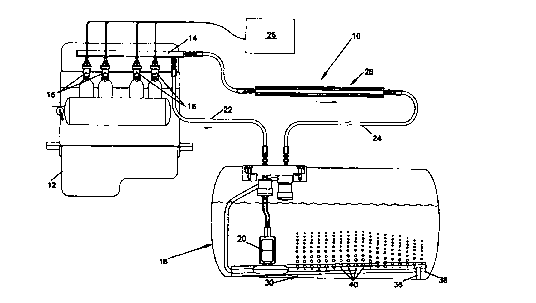Some of the information on this Web page has been provided by external sources. The Government of Canada is not responsible for the accuracy, reliability or currency of the information supplied by external sources. Users wishing to rely upon this information should consult directly with the source of the information. Content provided by external sources is not subject to official languages, privacy and accessibility requirements.
Any discrepancies in the text and image of the Claims and Abstract are due to differing posting times. Text of the Claims and Abstract are posted:
| (12) Patent Application: | (11) CA 2289859 |
|---|---|
| (54) English Title: | LIQUEFIED PETROLEUM GAS FUEL SYSTEM AND METHOD |
| (54) French Title: | SYSTEME ET PROCEDE D'ALIMENTATION EN GAZ DE PETROLE LIQUEFIE |
| Status: | Deemed Abandoned and Beyond the Period of Reinstatement - Pending Response to Notice of Disregarded Communication |
| (51) International Patent Classification (IPC): |
|
|---|---|
| (72) Inventors : |
|
| (73) Owners : |
|
| (71) Applicants : |
|
| (74) Agent: | ROBIC AGENCE PI S.E.C./ROBIC IP AGENCY LP |
| (74) Associate agent: | |
| (45) Issued: | |
| (86) PCT Filing Date: | 1998-05-11 |
| (87) Open to Public Inspection: | 1998-11-19 |
| Availability of licence: | N/A |
| Dedicated to the Public: | N/A |
| (25) Language of filing: | English |
| Patent Cooperation Treaty (PCT): | Yes |
|---|---|
| (86) PCT Filing Number: | PCT/US1998/009533 |
| (87) International Publication Number: | WO 1998051923 |
| (85) National Entry: | 1999-11-12 |
| (30) Application Priority Data: | ||||||
|---|---|---|---|---|---|---|
|
A fuel supply system and method for reducing the pressure in the fuel tank for
a liquefied petroleum gas fuel supply system in which fuel is returned to the
tank. Return fuel is cooled by heat transfer devices in the return line in
line and in the tank.
Système et procédé d'alimentation en carburant permettant d'abaisser la pression à l'intérieur d'un réservoir à carburant. Ce système convient pour une alimentation en gaz de pétrole liquéfié, dans lequel le carburant est renvoyé au réservoir. Le carburant de retour est refroidi par des dispositifs de transfert thermique disposés dans la conduite de retour, dans la conduite d'alimentation et dans le réservoir.
Note: Claims are shown in the official language in which they were submitted.
Note: Descriptions are shown in the official language in which they were submitted.

2024-08-01:As part of the Next Generation Patents (NGP) transition, the Canadian Patents Database (CPD) now contains a more detailed Event History, which replicates the Event Log of our new back-office solution.
Please note that "Inactive:" events refers to events no longer in use in our new back-office solution.
For a clearer understanding of the status of the application/patent presented on this page, the site Disclaimer , as well as the definitions for Patent , Event History , Maintenance Fee and Payment History should be consulted.
| Description | Date |
|---|---|
| Inactive: IPC from MCD | 2006-03-12 |
| Inactive: IPC from MCD | 2006-03-12 |
| Inactive: IPC from MCD | 2006-03-12 |
| Application Not Reinstated by Deadline | 2004-05-11 |
| Inactive: Dead - RFE never made | 2004-05-11 |
| Deemed Abandoned - Failure to Respond to Maintenance Fee Notice | 2004-05-11 |
| Inactive: Abandon-RFE+Late fee unpaid-Correspondence sent | 2003-05-12 |
| Letter Sent | 2000-11-23 |
| Reinstatement Requirements Deemed Compliant for All Abandonment Reasons | 2000-11-10 |
| Deemed Abandoned - Failure to Respond to Maintenance Fee Notice | 2000-05-11 |
| Letter Sent | 2000-05-05 |
| Inactive: Single transfer | 2000-03-28 |
| Inactive: Cover page published | 2000-01-12 |
| Inactive: IPC assigned | 2000-01-10 |
| Inactive: First IPC assigned | 2000-01-10 |
| Inactive: Courtesy letter - Evidence | 1999-12-21 |
| Inactive: Notice - National entry - No RFE | 1999-12-14 |
| Application Received - PCT | 1999-12-13 |
| Application Published (Open to Public Inspection) | 1998-11-19 |
| Abandonment Date | Reason | Reinstatement Date |
|---|---|---|
| 2004-05-11 | ||
| 2000-05-11 |
The last payment was received on 2003-04-03
Note : If the full payment has not been received on or before the date indicated, a further fee may be required which may be one of the following
Please refer to the CIPO Patent Fees web page to see all current fee amounts.
| Fee Type | Anniversary Year | Due Date | Paid Date |
|---|---|---|---|
| Basic national fee - standard | 1999-11-12 | ||
| Registration of a document | 2000-03-28 | ||
| MF (application, 2nd anniv.) - standard | 02 | 2000-05-11 | 2000-11-10 |
| Reinstatement | 2000-11-10 | ||
| MF (application, 3rd anniv.) - standard | 03 | 2001-05-11 | 2001-04-04 |
| MF (application, 4th anniv.) - standard | 04 | 2002-05-13 | 2002-04-02 |
| MF (application, 5th anniv.) - standard | 05 | 2003-05-12 | 2003-04-03 |
Note: Records showing the ownership history in alphabetical order.
| Current Owners on Record |
|---|
| BENNETT TECHNOLOGIES, L.L.C. |
| Past Owners on Record |
|---|
| DAVID E. BENNETT |